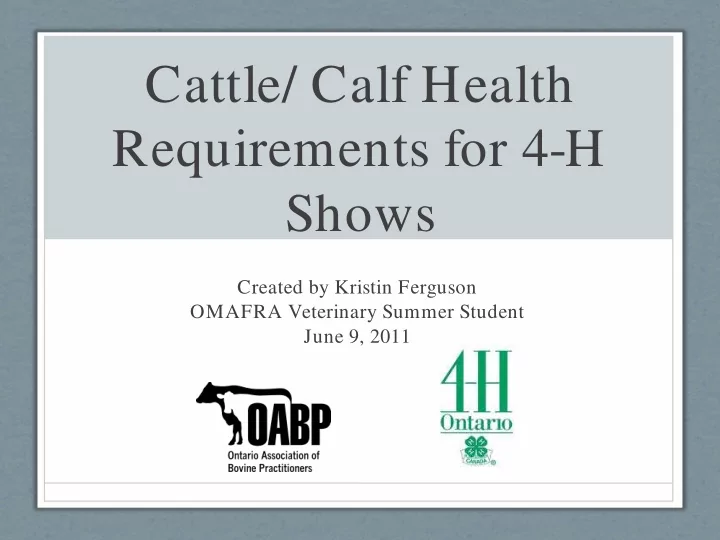

Cattle/ Calf Health Requirements for 4-H Shows Created by Kristin Ferguson OMAFRA Veterinary Summer Student June 9, 2011
What is the Problem? • Calves at shows that have infectious disease and could spread the disease to other calves or people
Confusion… • Who is responsible for making the decision if the calf can be shown? • Inconsistent rules or application of rules within or between areas
Why is it important? • Some infections can spread between cattle and people • Some cattle infections, caught at shows, can be • 4-H calves and shows brought back to home represent the dairy farms and affect the whole industry herd • Want to show healthy calves
Solution: Attention to Cattle Health Requirements 4-H calves must be : • free of any evidence of infectious diseases including ringworm and warts • healthy - bright and alert, normal appetite, normal temperature, free of respiratory disease and free of diarrhea • vaccinated, according to vet recommendations, against the common viral diseases prior to a show
Who is responsible for this? • 4-H members • Parents • Calf owners • Club leaders If the calf is showing any signs of disease it is your responsibility to contact the 4-H leader to find alternative solutions
How to recognize contagious, infectious diseases
Ringworm • Highly contagious! • Caused by a fungus that invades hair, hair follicles and the surrounding skin • Takes months for the body’s immune system to fight it off and skin to heal
Ringworm • Can spread from calf to calf and also to people (4H’ers and public) Spread by: • Direct contact • Contaminated objects (grooming tools, clipper blades or tack)
How to recognize ringworm • Patches of hair loss with grey-white crust/ scab • White calves can show pink rings on skin before hair loss • Usually around the eyes, patches can also be found on the chest and legs
Warts • Highly contagious, especially among young cattle! • Not contagious to people • Can be caused by 4 different viruses • Warts typically appear two months after exposure to the virus and may last for over a year
Warts • Spread from calf to calf • Spread by: • Direct contact between cattle • Contaminated objects (grooming tools, clipper blades or tack) • Possibly by insects
How to recognize warts • Found on the head, neck and shoulders • Occasionally on the back and abdomen • Hairless round bumps • Can be just a few or many that look like small cauliflower-like swellings
Lice • Wingless, flattened insects • Some species feed off blood • Spread by: • Direct contact between cattle • Contaminated objects (grooming tools, clipper blades or tack)
How to recognize lice • Presence of lice or eggs • Skin irritation from scratching, rubbing or biting • Rough hair coat Courtesy of Dr. J.D. Baird
Other common viral infections of cattle • IBR (Infectious Bovine Rhinotracheitis) • BVD (Bovine Viral Diarrhea) • BRSV (Bovine Respiratory Syncytial Virus) • PI-3 (Parainfluenza Virus 3)
How to recognize viral diseases • Temperature (above 38.6 ° C) • Dull and Depressed • Loss of Appetite • Respiratory Signs (wheezing, coughing, nasal discharge) • Diarrhea
How could I be prevented from showing? • If the calf has any signs of disease • Ringworm- any patches of hair loss, regardless of the absence of a white scab or if it looks like it is healing and hair is growing back. - for white calves, if any pink rings can be seen • Warts- any warts present, does not matter how many You cannot tell from visual inspection whether skin lesions are infectious or not therefore, there is a zero tolerance policy • Lice- if any is present • Viral Diseases- calf has a temperature, is depressed, off feed, respiratory signs or diarrhea
requirements important? Why are the health
Prevention: At the show • Do not bring calves to shows if they are visibly ill or under treatment • Consult the herd vet to ensure the animal poses no risk to itself or others • Reduce contact between calves and between calves and people • Clean grooming tools frequently • Do not share equipment (grooming, buckets, feed tubs) between calves
Prevention: At the show • Get veterinary advice about vaccination • Consider vaccinating for common, highly contagious viral diseases such as IBR, BVD, BRSV and PI-3 • Complete the vaccination protocol for calves at least two weeks prior to their first show
Prevention: On the home farm • Ideally, show calves should be housed separately from their herd mates for the entire duration of the show season • Calves should remain segregated (quarantined) from the rest of the herd for several months after the last show
What are the consequences?
Take home message…. • At least 2 weeks prior to each 4-H show: • Ensure calves are free of any signs of contagious disease • Have been vaccinated appropriately IF, after examining the calf, you are unsure if the calf is eligible to be shown, contact the 4-H leader. If the leader needs further assistance, he/ she should consult the herd veterinarian
These requirements are put in place to protect everyone attending the show
Thank You
Recommend
More recommend